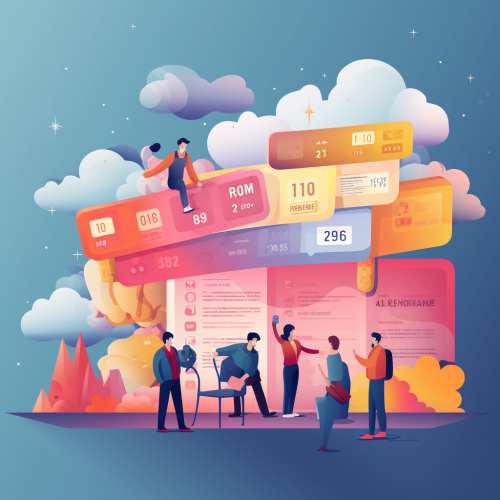Ticket Triage Meaning: Benefits & Applications In Support Tickets
What is Ticket Triaging?
Ticket triaging in customer support is a systematic process of sorting and prioritizing incoming customer support tickets. When customers reach out with queries or issues, these are logged as tickets in a support system—triage support tickets help efficiently address customer queries and improve support workflows.
The ticket triaging process involves quickly assessing the nature of the problem, categorizing it based on type, assigning ticket priority levels, and then routing the ticket to the appropriate support team or individual. Automation tools are often used to categorize, assign, and escalate tickets to appropriate team members, streamlining the triage process and improving efficiency. Categorizing tickets not only helps with resolution but also reveals common problems, enabling organizations to address root causes. After priority levels are assigned, a prioritization matrix is used to define ticket importance by cross-referencing urgency against impact. High-priority tickets, such as critical issues like system outages, are addressed first, while low-priority tickets (e.g., feature requests) can be managed more flexibly. The customer support team and customer service teams play a key role in managing and prioritizing support tickets to ensure effective resolution and enhanced customer satisfaction. Automation may be employed for efficiency, and continuous monitoring ensures timely resolution and customer satisfaction. Ticket triage is important because it ensures critical support tickets are prioritized and routed to the right team, improving response times and customer satisfaction. This method streamlines the support workflow, ensuring that urgent matters receive prompt attention while efficiently allocating resources for comprehensive issue resolution through a service desk ticket triage system.
Types of Support Tickets
Support tickets come in many forms, each requiring a tailored approach within the ticket triage process. Understanding the different types of support tickets helps the support team efficiently categorize, prioritize, and resolve incoming requests, ensuring a smooth support workflow. Here are the most common types of support tickets:
Incident tickets: Raised for technical issues such as software bugs or hardware malfunctions that disrupt normal operations.
Service request tickets: Generated when customers request information about services, need help with subscriptions, or want to make changes to their plans.
Change request tickets: Created when customers ask for new features, integrations, or product updates to be enabled in their accounts.
Problem tickets: Used to report recurring technical issues that require deeper investigation and long-term solutions.
Task tickets: Internal tickets for the support team to track and prioritize daily operational tasks, such as analyzing customer data or updating documentation.
Feature request tickets: Submitted by customers who want new features added to the product, providing valuable input for the development roadmap.
Escalation tickets: Raised when an issue cannot be resolved by the initial support team and needs to be escalated to senior or specialized teams.
Bug report tickets: Filed by customers to report software bugs, helping the team track and resolve defects efficiently.
Complaint tickets: Submitted by customers dissatisfied with a product or service, offering insights into customer sentiment and areas for improvement.
Outage tickets: Raised when customers experience downtime or cannot access a service due to server failures or other disruptions.
Inquiry tickets: Created when customers have questions about products or services, such as feature details or usage instructions.
Account management tickets: Used for specific requests related to customer accounts, like data fetches, adding new users, or updating account details.
Follow-up tickets: Generated when customers need additional assistance after an initial resolution, ensuring issues are fully addressed.
Internal IT support tickets: Raised by employees facing technical issues, such as login problems or hardware failures.
Security incident tickets: Created for cybersecurity concerns, including data breaches or unauthorized access, which are often treated as high priority alongside account management and incident tickets.
By accurately identifying and categorizing these support tickets, the support team can streamline the triage process, prioritize tickets effectively, and deliver high quality customer support.
Why Does Ticket Triaging Matter?
Ticket triaging matters because it streamlines the customer support process by efficiently sorting, categorizing, and prioritizing incoming customer support tickets. This ensures that urgent issues receive prompt attention, resources are allocated effectively, and customers receive timely and appropriate assistance, ultimately leading to improved customer satisfaction and a more efficient support operation.Properly categorizing and routing tickets to the relevant customer support teams is crucial for ensuring timely and effective resolution of customer issues.Ticket triaging provides several benefits, contributing to the efficiency and effectiveness of support operations. Here are some key advantages:
Efficient Resource Allocation:
By categorizing and prioritizing customer support tickets, support teams can allocate resources more efficiently. Urgent issues receive prompt attention, preventing bottlenecks and improving overall response times. Effective triage also helps reduce ticket backlogs, ensuring that support teams are not overwhelmed by unresolved requests.
Improved Response Times:
Prioritizing support tickets based on urgency ensures that critical issues are addressed promptly. This leads to faster response times and enhances customer satisfaction.
Enhanced Customer Satisfaction:
Timely and accurate resolution of customer issues contributes to higher customer satisfaction. Customers appreciate receiving prompt assistance, especially for urgent matters.
Specialized Expertise:
Ticket triaging enables the routing of tickets to the most suitable support teams or individuals based on their expertise. This ensures that each issue is handled by personnel with the right skills and knowledge. Tiered support levels ensure that senior agents focus on high-complexity problems, maximizing the use of specialized expertise.
Reduced Workload for Support Teams:
Automation of routine tasks in the triaging process reduces the workload on support teams. This allows them to focus on more complex issues that require human intervention.Monitoring customer feedback helps assess and improve the ticket triage process by providing valuable insights into customer experiences and identifying areas for enhancement.KPIs such as First Response Time (FRT) and Ticket Backlog Size are regularly audited to measure the effectiveness of the ticket triage process.
Best Practices for Ticket Triaging
Implementing effective ticket triaging is crucial for streamlined customer support. Here are some best practices:
Automation: Use automation to categorize and assign initial ticket priorities based on predefined rules. This speeds up the ticket triage process and ensures consistency. Implementing support ticket triage can further improve efficiency and customer satisfaction by automating the prioritization and routing of tickets. Intelligent ticket triaging leverages AI-powered tools to automate and optimize the organization, prioritization, and categorization of support tickets, ensuring alignment with workflow requirements.
Clear Categorization: Develop a clear and comprehensive categorization system for tickets. This helps route them to the right teams or individuals, improving response time and issue resolution. Use a system to mark tickets based on urgency and business impact, often employing a point-based approach to identify which tickets require immediate attention.
Defined Priority Levels: Establish clear criteria for assigning priority levels to tickets. This ensures that urgent matters are addressed promptly while preventing backlogs in less critical issues.
Team Specialization: Assign tickets to teams or individuals based on their expertise. This ensures that issues are handled by the most qualified personnel, improving support quality.
Continuous Training: Keep support teams updated on new products, features, and common issues. This empowers them to handle a diverse range of tickets more effectively.
Monitoring and Metrics: Regularly monitor key performance indicators (KPIs) such as response time, resolution time, and customer satisfaction. Use these metrics to identify improvement areas and track the triaging process’s efficiency. AI can automatically read, tag, route, and prioritize every conversation based on specific needs.
Escalation Protocols: Define clear protocols for escalating tickets when necessary. This ensures that complex or critical issues are quickly escalated to the appropriate level of expertise for resolution.
Canned responses are pre-defined templates for common solutions that help standardize messaging and save time.Automation can help reduce incoming inquiries by as much as 65%, allowing support agents to focus on more complex issues.
Common Challenges in Ticket Triage
While the ticket triage process is essential for efficient support operations, it comes with its own set of challenges that can impact the overall support process. Some of the most common challenges include:
Handling complex customer inquiries: Some support tickets are difficult to categorize or require specialized knowledge, making it challenging for the support team to triage them quickly and accurately.
Resource allocation: Limited support agents can lead to bottlenecks, especially during peak times, resulting in delayed responses and unresolved tickets.
Managing ticket backlogs: When the volume of incoming tickets exceeds the support team’s capacity, ticket backlogs can accumulate, affecting response times and customer satisfaction.
Maintaining training and efficiency: Support agents need ongoing training to stay updated on new products, services, and processes, which is crucial for effective triage and resolution.
Balancing automation and human judgment: While automated ticket triage can handle routine tasks, complex or sensitive issues often require human intervention to ensure customer expectations are met.
Aligning with customer expectations and business objectives: The triage process must prioritize tickets not only by urgency but also by factors like customer loyalty and the business impact of the issue.
Addressing these challenges is key to maintaining an efficient ticket triage workflow and ensuring that customer inquiries are resolved promptly and effectively.
Real-World Examples of Ticket Triaging
Below are some interesting real-world examples of ticket triaging in various industries. Customer support ticket triage is a crucial part of service management, helping organizations manage and prioritize incoming support tickets efficiently by evaluating their urgency and impact. This process ensures that support inquiries are categorized and assigned based on priority, which improves response times and customer satisfaction.
In healthcare, ticket triage is used to prioritize patient inquiries and technical issues with medical equipment. Automation tools can help streamline the triage process by automatically categorizing and routing tickets to the appropriate teams.
In IT, service management platforms utilize ticket triage to handle a high volume of support requests, ensuring that critical system outages are addressed before less urgent issues. Automation tools can further enhance this process by prioritizing incoming support tickets and assigning them to the right specialists.
In e-commerce, customer support ticket triage helps manage order issues, payment problems, and product inquiries. Automation tools can be used to quickly sort and escalate tickets, improving workflow management and customer satisfaction.
Ticket Triaging in IT Support
Issue Identification: In an IT support setting, tickets could be categorized based on software bugs, hardware malfunctions, or network issues.
Priority Assignment: Urgent issues like server outages might be assigned the highest priority, while routine software glitches could have a lower priority.
Ticket Triaging in E-commerce Customer Support
Order Inquiries: Tickets may be categorized by the nature of the inquiry, such as order tracking, returns, or product information.
Priority Assignment: Urgent matters like missing shipments or payment issues might be prioritized over general product queries.
Customer support representatives handle the 20% of customer support requests that are complex, important, and require personalization or involvement of specific departments.
Ticket Triaging in Healthcare Support
Patient Inquiries: Tickets could be categorized by the inquiry type, such as appointment scheduling, prescription refills, or medical advice.
Priority Assignment: Urgent health concerns may be prioritized, while routine administrative tasks receive lower priority.
In each of these examples, ticket triaging involves categorizing, prioritizing, and routing tickets to the appropriate team or individual with the expertise to address the specific issue. This helps streamline the resolution process and ensures customer concerns are addressed efficiently.
Setting up ticket triage process
The first step is to identify what kinds of customer problems and demands your customers face, and the organization classifies these problems. Automation tools can assist in classifying and routing tickets to appropriate team members, streamlining the triage process and improving response times.
The last step in creating a workflow includes clearly defining the roles of customer support agents, the responsibilities of customer support teams, and AI customer support in ticket triage.
Establish Your Case Categorization Structure

There is no one solution for determining which tickets will be processed. The seriousness of an emergency customer support ticket is an important factor for a business; some companies may sort customer support ticket severity by priority. However, it is essential that managers identify what qualifies as urgent and what qualifies as less priority and, therefore, have to identify the characteristics of different severity levels. Size of customers/revenues.
Define characteristics that denote severity levels
Teammates must identify characteristics that differ in severity to know how to approach the tickets. What makes a distinction between threes and fives? You have to remember all levels of a problem and look at its impact on businesses. A major severity level misstatement is an overly broad or vague definition. Therefore, rather than defining things numerically, it is better to understand which issues could affect your business.
Allocate Agents and Define Roles
Once you get your ticket in the appropriate place, you need the correct person to handle your ticket and wait until it arrives. The problem with sending a ticket to “Network Connectivity buckets” is that nobody else has a way of handling this ticket. For the best possible triage process, allocate customer support agents to the proper team and define roles. Everyone in the team needs the knowledge of tasks to be done and who has other responsibilities. The system eliminates misunderstanding and helps engineers understand the entire system.
Understanding Ticket Status in the Triage Workflow
Ticket status plays a vital role in the support process, providing visibility into where each ticket stands within the triage workflow. Common ticket statuses include:
Open: The ticket has been received and is awaiting assignment to a support agent.
In Progress: A support agent is actively working on the ticket to resolve the issue.
Pending: The ticket is on hold, often waiting for additional information or action from the customer.
Resolved: The support agent has addressed the issue, and the ticket is ready to be closed.
Closed: The ticket is officially closed, indicating that the issue has been fully resolved and no further action is required.
Effectively managing ticket status is essential for efficient ticket triage, as it helps the support team prioritize tickets, allocate resources, and keep customers informed about the progress of their requests.
Automate Ticket Routing Workflows
Automatization improves the reliability of helpdesks using standard support ticketing. Automating ticket processing can help you prioritize tickets, identify issues, and resolve those issues. Support software specially designed for help desks can retrieve relevant Support histories and send these summaries along with current ticket information. This saves time and effort for the assigned Support Agents and ensures they'll get all the necessary details to resolve any problem.
You can automate routing tickets by setting up automation rules within your ticketing system based on trigger events. These rules define conditions for categorizing tickets and assigning priority levels.

Measuring the Effectiveness of Ticket Triage
To ensure the ticket triage process is delivering optimal results, it’s important to measure its effectiveness using key performance indicators (KPIs). These metrics help the support team identify strengths and areas for improvement within the support process:
First Response Time (FRT): Measures how quickly the support team responds to new tickets, reflecting the efficiency of the triage process.
Resolution Time: Tracks the total time taken to resolve a ticket from the moment it is opened, indicating how effectively the team manages and prioritizes tickets.
Ticket Volume: The number of support tickets received in a given period, helping to assess workload and resource allocation.
Resolution Rate: The percentage of tickets resolved within a specific timeframe, showing the support team’s ability to handle incoming requests efficiently.
Customer Satisfaction (CSAT): Collected through surveys or feedback forms, this metric gauges how satisfied customers are with the support they received.
Ticket Priority Accuracy: Evaluates how accurately tickets are prioritized, ensuring that high priority and urgent issues are addressed promptly.
Regularly analyzing these KPIs allows support teams to refine the ticket triage process, improve response times, and enhance overall customer satisfaction.
Future Trends and Developments
As ticket triaging continues to evolve, several emerging trends and developments are shaping the future of support ticket management. This section explores key advancements and their implications for improving efficiency, enhancing customer experiences, and driving innovation in support operations.
Advances in AI and Machine Learning for Ticket Triaging
The integration of artificial intelligence (AI) and machine learning (ML) technologies is revolutionizing ticket triaging processes. AI-powered algorithms can analyze large volumes of ticket data, identify patterns, and predict the nature, severity, and resolution time of incoming tickets with remarkable accuracy. By leveraging AI and ML, ticket triaging systems can automate decision-making processes, prioritize tickets more effectively, and route them to the most appropriate teams or agents for resolution. Additionally, AI-driven ticket triaging systems can continuously learn and adapt based on real-time feedback and evolving support dynamics, leading to improved efficiency, faster resolution times, and enhanced customer satisfaction.
Integration with Emerging Technologies such as Chatbots and Virtual Assistants
The integration of ticket triaging systems with emerging technologies such as chatbots and virtual assistants is reshaping how support interactions are handled. Chatbots and virtual assistants serve as the first line of defense in ticket triaging, engaging with customers, gathering initial information, and routing tickets to the appropriate channels for further assistance. By combining ticket triaging capabilities with conversational AI, businesses can provide immediate responses to common inquiries, gather relevant details from users, and streamline the ticket creation process. This integration not only reduces response times but also enhances the overall customer experience by providing instant support and guidance.
Personalization and Hyper-Automation in Ticket Management
Personalization and hyper-automation are emerging as key trends in ticket management, driven by advancements in AI and data analytics. Ticket triaging systems are increasingly incorporating personalization capabilities to tailor support experiences based on individual customer preferences, behavior, and history. By analyzing customer data and interaction patterns, ticket triaging systems can personalize responses, recommendations, and solutions to meet the unique needs of each customer. Furthermore, customer self-service automation and hyper-automation technologies enable end-to-end automation of repetitive support tasks, from ticket creation and routing to resolution and follow-up. By automating routine processes and workflows, hyper-automation reduces manual intervention, accelerates resolution times, and frees up human agents to focus on more complex or high-value tasks, ultimately improving efficiency and productivity in support operations.
In summary, future trends and developments in ticket triaging are centered around leveraging advanced technologies such as AI, chatbots, virtual assistants, personalization, and hyper-automation to transform support operations. By embracing these innovations, businesses can enhance efficiency, responsiveness, and customer satisfaction, driving continuous improvement and innovation in support ticket management.
Ticket Triage and Customer Satisfaction
An effective ticket triage process is fundamental to delivering high quality customer support and achieving higher customer satisfaction. Here’s how ticket triage directly impacts the customer experience:
Prompt resolution of urgent issues: By prioritizing high priority tickets, the support team ensures that critical customer issues are addressed quickly, reducing frustration and building trust.
Timely updates and communication: Keeping customers informed about the status of their support tickets throughout the triage process helps manage expectations and fosters transparency.
Expert handling of customer issues: Assigning tickets to support agents with the right expertise increases the likelihood of first-contact resolution, leading to a smoother support experience.
Efficient and transparent support process: A well-structured ticket triage workflow minimizes delays, reduces ticket backlogs, and ensures that all customer inquiries are handled efficiently.
By focusing on efficient ticket triage, support teams can consistently deliver high quality customer support, exceed customer expectations, and build long-term customer loyalty.
Automate Ticket Triage Process With IrisAgent
IrisAgent's AI platform can help automate different steps of the ticket triage process.
Automated Categorization:
IrisAgent's AI, including natural language processing (NLP), can automatically analyze the content of incoming tickets and categorize them based on predefined criteria. This helps in sorting tickets into relevant groups.
Priority Assignment:
IrisAgent can assess the urgency and impact of a ticket, allowing for automatic assignment of priority levels. This ensures that critical issues are addressed promptly.
Keyword Recognition:
IrisAgent can identify keywords and phrases within ticket content to determine the nature of the inquiry or problem. This aids in quick and accurate categorization.
Learning from Historical Data:
Machine learning algorithms can analyze historical ticket data to identify patterns and trends. This information helps improve the accuracy of ticket categorization and prioritization over time.
AI-driven automation workflows can be set up to handle routine and repetitive tasks associated with ticket triage, freeing up human agents to focus on more complex issues.
Smart Routing:
AI can intelligently route tickets to the most appropriate support teams or individuals based on their expertise, ensuring that the right personnel handles each issue.
Frequently Asked Questions
What is ticket triage process?
Ticket triage process is the process of categorizing, prioritizing, and assigning support tickets to appropriate teams or individuals based on predefined criteria.
Why is triaging tickets important?
Triaging tickets is crucial for efficiently managing customer support. It ensures that urgent issues receive prompt attention, resources are allocated effectively, and customers receive timely assistance.
How does one triage tickets?
Ticket triage involves analyzing incoming support tickets, categorizing them based on issue type, assigning priority levels, and routing them to the most suitable support teams or individuals.
What criteria are used for ticket prioritization?
Prioritization criteria may include the urgency of the issue, its impact on the customer, and predefined business rules. High-priority tickets typically involve critical issues that require immediate attention.
Can ticket triage system be automated?
Yes, ticket triage system can be automated using AI-driven tools. Automation helps in the quick and accurate categorization of tickets, reducing manual effort and improving efficiency.
What types of issues are suitable for automation in ticket triaging?
Routine and repetitive tasks, such as categorizing common issues or assigning initial priority levels based on predefined rules, are suitable for automation in ticket triaging.
What are some best practices for implementing ticket triaging?
Best practices include defining clear categories, establishing priority levels, utilizing automation, assigning tickets to specialized teams, implementing escalation protocols, and continuously monitoring and optimizing the process.
Book a demo today to automate your ticket triaging process and increase efficiency.





